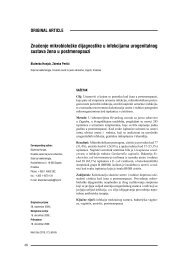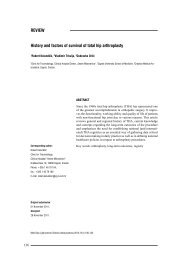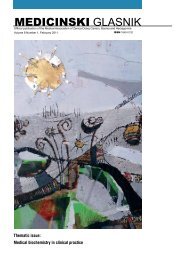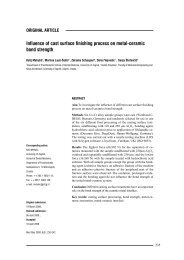MEDICINSKI GLASNIK
MEDICINSKI GLASNIK
MEDICINSKI GLASNIK
Create successful ePaper yourself
Turn your PDF publications into a flip-book with our unique Google optimized e-Paper software.
DISCUSSION<br />
Croatia is a country with characteristics of a<br />
socio-economic transition. The DMFT index is a<br />
good indicator of the degree of development and<br />
an important factor in designing and planning the<br />
national programmes of oral health starting from<br />
the earliest age (4).<br />
The data about the DMFT values in populations<br />
of recruits are relatively numerous. Morgan<br />
et al. (6) determined the DMFT values of 6.8 in<br />
Australian Navy recruits. In subjects of Australian<br />
army recruits Hopcraft and Morgan (7) determined<br />
a decline in the level of caries experience, with<br />
the mean DMFT scores for recruits aged between<br />
17-35 was 6.08. For the subjects of the same age<br />
(17-25 years of age) in this study DMFT scores<br />
were only 4.11. Krejsa et al. (8) established the<br />
average DMFT value of 6.22 (DT: 0.87, MT: 0.02<br />
and FT: 5.33) in 18-year-old Czech recruits. Antoft<br />
et al. (9) found a decrease of caries of 63% in<br />
Danish recruits in the period between 1972-1993<br />
(DMFT 6.2. in 1993), Willerhausen et al. (10)<br />
found the average DMFT index of 13.0 in German<br />
recruits, and Klimek et al. (11) the value of<br />
7.5. In Italian recruits the determined DMFT was<br />
7.14 (12). Asmyhr et al. (13) revealed caries decrease<br />
in Norwegian recruits to the DMFT value<br />
of 10.2. In the study of Swiss recruits Menghini et<br />
al. (14) established the DMFT values of 10.1 (DT:<br />
4.2, MT: 0.5 and FT: 5.4), and in 1996 Menghini<br />
et al. (15) found a decline in caries of 48%, which<br />
amounted to 5.06. In Royal Air Force recruits Richardson<br />
and McIntyre (16) revealed a caries decrease<br />
to DMFT 6.5. A study of Turkish recruits<br />
(17) established the DMFT values of 6, with a<br />
significant relationship between the DMFT value<br />
and sugar consumption. A common characteristic<br />
of all results in these studies is significant caries<br />
decrease in recruits, and the determined DMFT<br />
Badel et al Oral health of the army recruits<br />
values which are mostly lower than those determined<br />
in our study of the Croatian army recruits.<br />
Specific characteristics of various age and<br />
social populations in Croatia with respect to age<br />
and social status are discussed in many studies. In<br />
the former Yugoslavia there were great differences<br />
between caries prevalence between the developed<br />
and undeveloped Federal Republics. The average<br />
DMFT value for 12-year-olds amounted to 6.1 and<br />
for 18-year-olds as high as 10.9 (21). The spread of<br />
caries was exceptionally wide, and therefore, the<br />
DMFT index for the age range between 19 and 29<br />
amounted between 10.18 and 12.48 (22). Lobnik-<br />
Gomilšek (23) found the average DMFT index of<br />
8.06 for military recruits in the Federal Republics<br />
of the former Yugoslavia (for the subjects from<br />
rural areas 7.64 and urban areas 8.52). In Croatia<br />
the average DMFT value was 8.41 (DT: 3.87, MT:<br />
1.15 and FT: 3.39), with a higher value in urban<br />
areas. According to our results for Croatian recruits,<br />
a decline in caries of 7.7% was found. In<br />
the analysis of single values share of DMFT it can<br />
be concluded that there is a decline of decayed<br />
teeth for 48%, whereas there is an increase of filled<br />
teeth for 25%. An increase in the number of missing<br />
teeth for 30% is unfavourable. Previous studies<br />
of Croatian recruits showed that the most common<br />
oral disease was dental caries (value 5.84),<br />
and in 2000 healthy teeth were found in only 4%<br />
subjects, but with better values of the investigated<br />
indices. The DMFT=6 value was lower, and the<br />
FST=25 value was higher (18, 19).<br />
Epidemiological studies provide valuable data<br />
on the health status of groups of inhabitants, assessing<br />
the prophylactic measures that have been implemented.<br />
They also provide guidelines for improvement<br />
of oral health, which is especially important in<br />
European countries in transition (24-26).<br />
Table 3. Test differences of the DMFT index and FST index in subgroups of the subjects according to the number of toothbrushing<br />
per day (average and standard deviations for frequency) by means of variance analysis*<br />
Subgroups No of subjects DMFT DT MT FT FST<br />
1 time per day 264 7.25±4.84 3.54±3.30 1.28±1.99 2.43±3.26 23.18±4.30<br />
2 times per day 214 7.50±4.94 2.84±3.16 1.34±1.84 3.32±3.75 23.82±3.97<br />
3 times per day 27 6.67±4.35 1.89±2.52 0.93±1.30 3.85±4.15 25.19±3.16<br />
Probability statistical test 0.659 =0.007 =0.571 =0.008 =0.026<br />
*DMTF, Decayed, Missing, Filled, Teeth; DT, Decayed, Teeth; MT, Missing, Teeth; FST, Filled and Sound Teeth<br />
259












